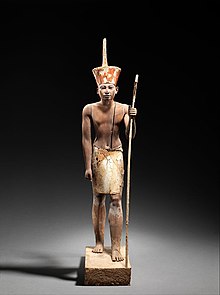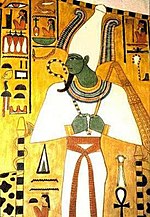Crowns of Egypt
The Egyptian civilization used a number of different Crowns throughout its existence. Some were used to show authority, while others were used for religious ceremonies. Each Crown was worn by different Pharaohs or deities, and each Crown had its own significance and symbolic meaning. In early Egypt, one significant and important characteristic of the many Crowns, was the color white. The color symbolized kingship or nisut in the early periods and Upper Egypt. The color blue was also an important color from the 18th Dynasty on.[1] The Crowns include the Atef, the Deshret, the Hedjet, the Khepresh, the Pschent, and the Hemhem.
| Image | Name | Components | Worn by | In art |
|---|---|---|---|---|
 |
Atef | Hedjet with ostrich feathers and sometimes Uraeus and ram horns |
Osiris and some other gods. | |
 |
Cap crown | Skullcap, band, streamers and Uraeus | Nobility and Pharaohs, typically |  The Wilbour Plaque,c. 1352–1336 B.C.E., Brooklyn Museum 16.48, probably depicting Akhenaten and Nefertiti. On the left, the Pharaoh wears the Khat headdress, and on the right, the queen wears the Cap crown. |
 |
Deshret (Red crown) |
Uraeus |
Pharaohs of Lower Egypt and the desert Red Land; the deities Horus, Wadjet and Neith |
|
 |
Hedjet (White crown) |
Vulture | Pharaohs of Upper Egypt; the deities Horus and Nekhbet |
|
 |
Hemhem crown | Hedjet, Uraeus and ram horns | Non-Egyptian rulers, certain gods |  A winged figure in Elamite robes, likely Cyrus the great wearing a Hemhem crown |
 |
Khat | Bands and Uraeus | Nobility and Pharaohs, typically |  The Wilbour Plaque, c. 1352–1336 B.C.E., Brooklyn Museum 16.48, probably depicting Akhenaten and Nefertiti. On the left, the Pharaoh wears the Khat headdress, and on the right, the queen wears the Cap crown. |
 |
Khepresh (Blue crown or War crown) |
Uraeus | New Kingdom Pharaohs in battle and ceremonies |
|
 |
Nemes | lappets, band and Uraeus | Pharaohs, typically |  Amenhotep II wearing a Nemes, KV35, Valley of the Kings, c. 1427–1401 B.C.E. |
 |
Pschent, Greek ψχεντ, Egyptian sḫm.tỉ, sekhemti (Double crown) |
Deshret and Hedjet; Uraeus and Vulture |
Pharaohs, and Horus | |
| Shuti crown | ram horns, feathers and Uraeus | Egyptian gods, typically |  Seti I perform rituals before the god Amun who is wearing the Shuti crown. From the Temple of Seti I at Abydos. | |
 |
Vulture crown | Vulture | Egyptian queens, typically |  Tomb wall depicting Queen Nefertari, the great royal wife of Pharaoh Rameses II |
Atef, the Crown of Osiris, is a combination of Upper Egypt's White crown, the Hedjet, and ostrich feathers on either side. It also often has a golden disc at its tip. The ostrich feathers, similar to those representing ma’at, symbolize truth, justice, morality, and balance.[2] They represent the cult center of Orisis as well, which is located in Abydos.[3] The Atef is typically worn atop a pair of ram or bull horns as a circlet. The Atef crown is seen as far back as the 5th dynasty.[citation needed] According to Egyptian beliefs, this Crown represents Osiris as the god of fertility, ruler of the afterlife, and a representative of the cycle of death and rebirth. Later on, though, it came to be worn by other Pharaohs because of the belief that they would become a form of Osiris after their death.[4] In their tombs, the Pharaohs would have themselves depicted as Osiris by wearing his Crown.[4] During Middle Kingdom Egypt, even regular citizens could have Osiris's Crown because Osiris had become the judge of the deceased.[5] It was also worn during religious rituals.
Cap crown
[edit]Attested as early as the Old Kingdom, the Cap crown is most commonly associated with the Dynasty 25 Kushite Pharaohs, who are frequently depicted wearing the Crown with two uraei.[6] In that era, the Crown was referred to as a sdn.[7] The remnants of what appears to be a Cap crown (JE 62699) were found on the mummy of Tutankhamun.[8] Tutankhamun's Crown consisted of a band of gold wrapped around the Pharaoh's temples that secured a linen skullcap, which had mostly decayed by the time of the tomb's excavation. The gold band was itself kept in place by a ribbon tied into a bow at the back of the head. Still remaining and mounted on the skullcap are four uraei made of gold beads and red and blue glass beads. In the center of each Uraeus is a gold cartouche containing the name of the Aten. The skullcap portion of the Crown resembles, and was likely associated with, the skullcap worn by the deity Ptah.

The Crown of Lower Egypt, also known as Deshret, is a red bowl shaped Crown with a protruding curlicue. It is typically associated with the rulers and Pharaohs of Lower Egypt. The word Deshret is also the name for the arid land surrounding the Nile River area.[10]
The red color of the Crown is symbolic of the “red land”, arid desert land that surrounded the fertile “black land” of Kemet.[11] The curlicue of the Crown is symbolic of the proboscis, or stinger, of the honey bee.[citation needed] The Crown was woven, like a basket, of plant fiber, perhaps grass, straw, flax, palm leaf, or reed. It is theorized that it was passed down from Pharaoh to Pharaoh instead of being buried with each Pharaoh, which might explain why no actual Deshret has been found.[10]
Representations of the Deshret can be seen as early as the late Naqada I period, around 3500 BCE. In these early predynastic times, it is believed the Crown was worn in association with the god Set, and it was not until the formation of the first dynasties, around 3000 BCE, that it became symbolic of rule over Lower Egypt.[12]
In Egyptian mythology, it is believed that Deshret was first given to the god Horus by Geb to symbolize his rule over Lower Egypt. The Crown was then passed on to Pharaohs, who saw themselves as successors to Horus.[10] The goddess Neith, when depicted in a human body, is usually shown wearing the Crown of Lower Egypt. The earliest depiction of Neith in this Crown was first found in the temple of Userkaf in Abu Gorab, which was constructed in 2499 BCE.[13]
The Hedjet, also known as hdt, is the Crown worn by the Pharaoh of Upper (Southern) Egypt. It resembles a bowling pin and is also called the “White One.” In addition, this Crown is one half of the Double crown, the Pschent. No Crowns are known to have been found in any archeological digs. Some Egyptologists have speculated that the Hedjet was made out of leather, felt, or some other fabric.[14] Another possibility is that it was woven like a basket, as the Deshret (Red crown) is known to have been, of plant fiber. A Hedjet with Nekhbet the Vulture goddess next to the head of the cobra goddess is the symbol used to represent the Hedjet. Several Egyptian gods, such a Nekhbet and Horus, are seen in some drawings and carvings wearing the Hedjet. Images of this Crown have been found in Ta-Seti (Northern Nubia in 3500–3200 BCE),[citation needed] a tomb in Deir-el-Bahari, the Narmer Palette, and on a statue of Pharaoh Sesostris I.[citation needed]
The Hemhem crown was an ornate triple Atef with corkscrew sheep horns and usually two Uraeus. The Egyptian word "Hemhem" means "to shout," "cry out," possibly indicating that the Hemhem crown represented a battle horn.[15]
The Double crown represented the unification of the two regions of Egypt, Upper and Lower Egypt. It is also referred to as the sekhemty, which means "The Two Powerful Ones", or as the Pschent.[14] The Pschent combines the Hedjet with the Deshret.[citation needed] An interesting inscription found in the tomb of a Fourth Dynasty Pharaoh states, “He has eaten the Red crown… and delights to have [the Crown’s] magic in his belly.” Historians believe this is a metaphorical reference to Upper Egypt conquering Lower Egypt as described on the Narmer Palette.[citation needed] Menes is credited with the invention of the Double crown, although the first Pharaoh to wear the Crown was Djet.[citation needed] Horus is depicted wearing the Double crown as well as Atum, both of which have a distinct relationship with the Pharaoh.[citation needed]As with the Deshret and Hedjet, no Pschent has been found; everything known about them comes from ancient tales, inscriptions, and depictions.[citation needed]
See also
[edit]References
[edit]- ^ Baines, John; Málek, Jaromír (1980). Atlas of Ancient Egypt. New York, NY: Facts on File Publications. p. 38. ISBN 0-7148-1958-1.
- ^ Smith, Cathy Anne (December 2018). "The Ostrich in Ancient Egypt | World History". Retrieved 2022-08-10.
- ^ "Expedition Magazine - Penn Museum". www.penn.museum. Retrieved 2022-08-10.
- ^ a b Dijkstra, Henk. History of the Ancient & Medieval World, Volume 2. New York: Marshall Cavendish, 1996. Print.
- ^ Mertz, Barbara. Temples, tombs, & hieroglyphs: a popular history of ancient Egypt. 2nd ed., 1st William Morrow ed. New York: William Morrow, 2007. Print.
- ^ Török, László (1997). Der Nahe und Mittlere Osten. Leiden: Brill. p. 284. ISBN 9789004104488. Retrieved 29 January 2015.
- ^ Goebs, Katja (2001). "Crowns". In Redford, Donald B. (ed.). The Oxford Encyclopedia of Ancient Egypt. Vol. 1. Oxford: Oxford University Press. ISBN 9780195102345.
- ^ "Tutankhamun: Anatomy of an Excavation: The Howard Carter Archives". The Griffith Institute. Retrieved 29 January 2015.
- ^ "Guardian Figure". www.metmuseum.org. Metropolitan Museum of Art. Retrieved 9 February 2022.
- ^ a b c Egyptian gods and goddesses, "Egyptian Symbols: Deshret." Accessed October 28, 2013. http://egyptian-gods.org/egyptian-symbols-deshret/
- ^ Jackson Spielvogel, Western Civilization, (Mason, Ohio: Cengage Learning, 2012), 16.
- ^ Toby Wilkinson, Early Dynastic Egypt, (Abingdon, Oxon: Routledge, 1999), 194-195.
- ^ George Hart, The Routledge Dictionary of Egyptian Gods and Goddesses, (Abingdon, Oxon: Routledge, 2005), 100.
- ^ a b Dunn, Jimmy. “The Crowns of Egypt, Part II: Specific Crowns.” Touregypt. n.p., 4 April 2011. Web. 26 Oct. 2013 <http://www.touregypt.net/featurestories/Crowns2.htm
- ^ Lobban Jr., Richard A. (2003). Historical Dictionary of Ancient and Medieval Nubia. Scarecrow Press. p. 364. ISBN 0810865785.
External links
[edit] Media related to Crowns of Egypt at Wikimedia Commons
Media related to Crowns of Egypt at Wikimedia Commons





